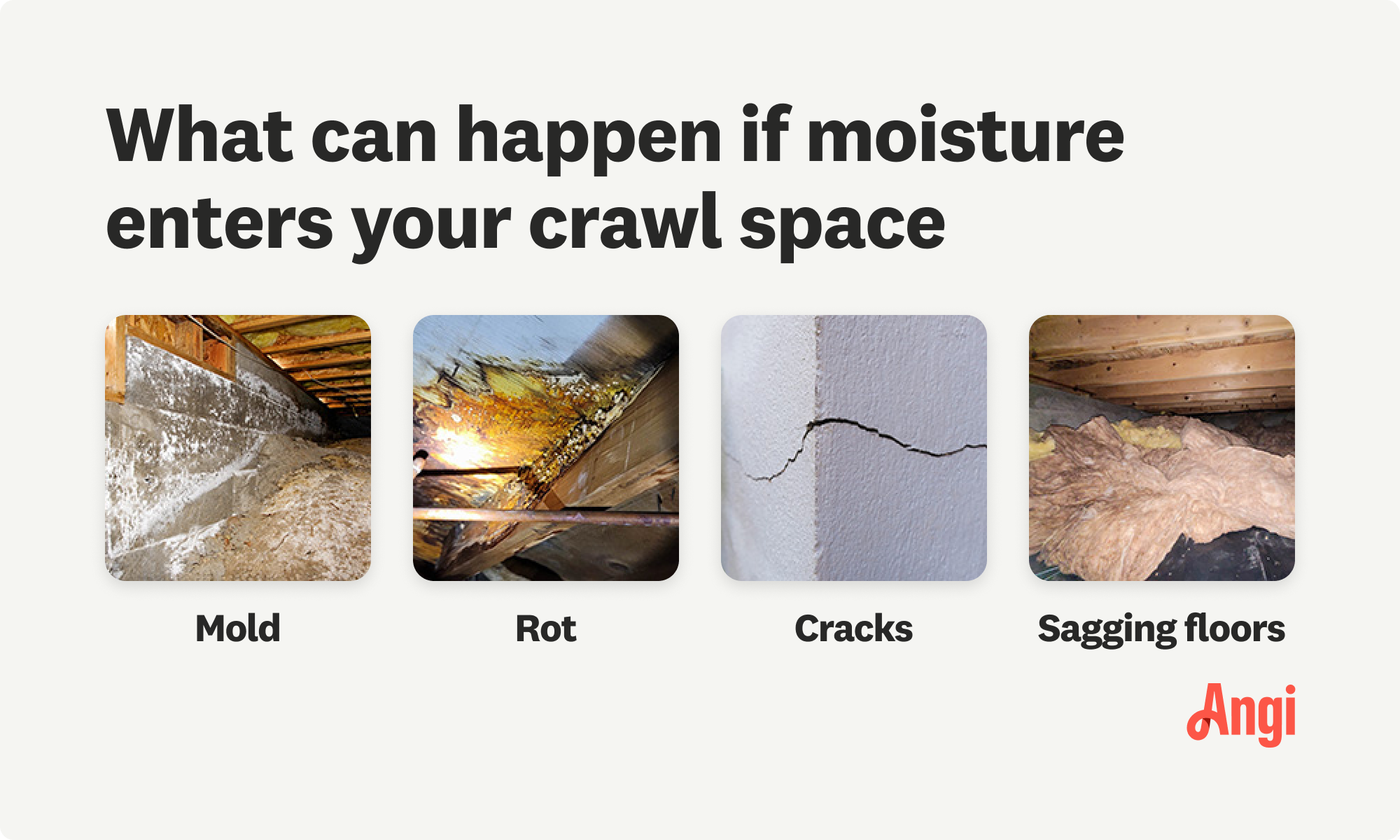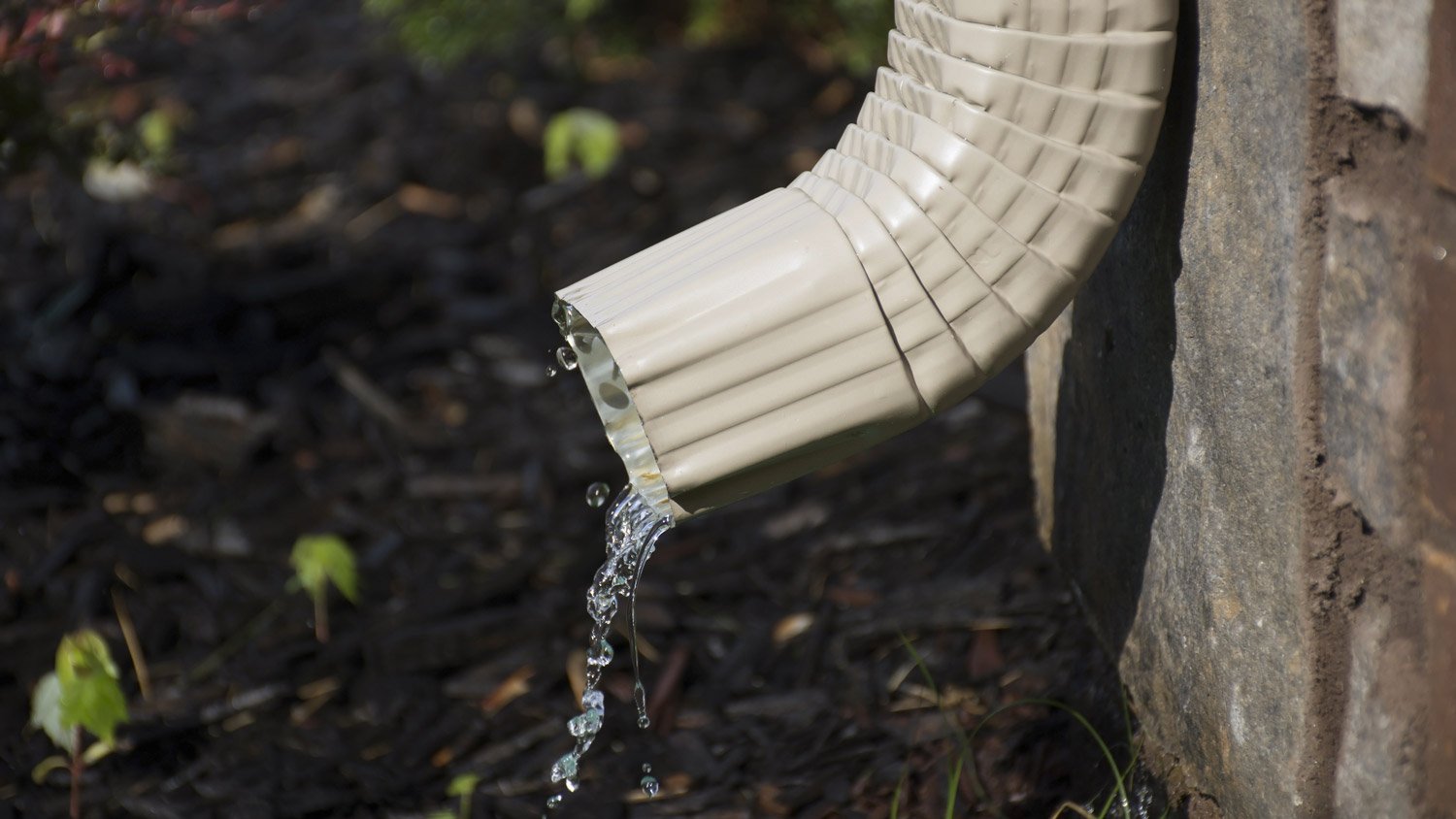
Crawl space repair costs can seem intimidating, but putting them off can lead to bigger issues. Learn about repair costs in this guide to set your budget.
Eliminating crawl space moisture reduces the risk of foundation damage and indoor humidity


Crawl spaces very commonly have issues with moisture build-up, which can contribute to poor indoor air quality, attract pests, promote mold growth, and even lead to rotting framing and damaged building materials in your home, possibly resulting in structural damage. Eliminating underhome moisture and keeping it at bay is crucial if you want to maintain a healthy home, prevent damage to your property, and avoid issues with resale. You can use these eight tips to get rid of crawl space moisture and keep the area dry.
If your crawl space is damp or contains standing water, consider installing a sump pump. Sump pumps work by pumping water that gets into your crawl space into your main sewer line, which helps prevent standing water and resulting humidity. They sit at the lowest part of your crawl space and include these components:
Sump liner
Pump
Alarm system
Pump stand
Check valve
Floor drain
You should also consider purchasing a battery backup system to accompany your sump pump. This system keeps your pump running in the event of a power outage during a storm or a flood event.
Sump pumps are especially useful in areas where flooding or heavy rain are common, but they can also protect your underhome area from water damage resulting from interior plumbing leaks, so they’re a great option no matter where you live.
According to data from Angi, the biggest reason homeowners hire pros for sump pump installation is basement flooding, making up about 34% of homeowner requests. 24% of homeowners install sump pumps as a form of preventative maintenance, and 17% of homeowners do so due to water leaking through walls.
A vapor barrier sits on the inside of your foundation walls and slab and creates a durable membrane that stops water vapor from entering the main crawl space area.
When installed professionally, a vapor barrier that’s fitted to the size of your crawl space will create reliable encapsulation and waterproofing that will reduce moisture for many years. Crawl space encapsulation costs around $5,500 on average and is well worth the investment.
Vapor barriers help keep insects and other pests out of your crawl space, and it helps prevent the stack effect—the process by which moisture under your home seeps up into your living area—from increasing the humidity on your main floors. Ultimately, a vapor barrier can improve your indoor air quality, reduce your electric bills—since most homeowners demand more from their HVAC systems to counteract humidity—and avoid wood-destroying insects (WDI) that can lead to structural issues.
If your crawl space has high humidity levels, you can prevent rot by blocking the outside air that's carrying humidity inward. The common culprits are vents, spaces under the sill plate, openings around pipes, openings around wires, rusted access doors, loose doors, and foundation cracks.
You can usually close seepage points with caulk or spray foam. However, it may be time to carry out crawl space repair if your issues are caused by things like leaky pipes or large foundation gaps that allow humidity to seep into your crawl space. It's also important to look for "weakest links" that could allow humidity to seep in. The goal is to find and seal even the smallest gaps to prevent any entry point for humid air.
It’s worth noting that there’s some debate about whether or not sealing a crawl space is a good idea, and some building departments may not allow it. Sealing can just trap moisture inside and make the humidity problems worse if you don’t couple your sealed crawl space with a dehumidifier, so keep that in mind as an extra expense when you’re getting an estimate from a basement waterproofing company near you.
Many homeowners believe that mold won’t form in a crawl space unless there’s an issue with standing or pooling water. In reality, only humidity is necessary for mold to grow, and a dehumidifier can fix that.
Crawl spaces require high-capacity and high-efficiency dehumidification systems with built-in air filtration since they’re usually quite prone to moisture build-up. It’s usually a good idea to have a self-draining humidifier installed and couple it with a sump pump. Otherwise, you’ll need to climb down into the space regularly, take out the tank, and empty it outside. A self-draining dehumidifier will remove moisture from the air and pump it into the sump pump for hands-off removal from your home.


One of the simplest things you can do to eliminate or reduce moisture issues in your crawl space is to make sure your gutters, downspouts, and gutter extenders are installed and working properly. These move runoff from your roof away from your foundation instead of letting it soak into the soil and, eventually, wick through the concrete and end up under your home.
If you've noticed that your crawl space is always moist after a storm, check the positioning of your gutters and downspouts to ensure that rainwater is flowing away from your home’s foundation.
A moisture issue that appears in your crawl space can actually begin on your roof. Clogged gutters can cause water to flow over the top of the gutter and land next to your foundation. That water will then soak into the soil, which will hold the moisture against the concrete foundation walls. Since concrete is porous, the water will wick through and evaporate under your home. It could also leak through cracks in the foundation wall, which also leads to underhome moisture issues.
Clean your gutters regularly to ensure that they’re free of leaves and debris as part of your routine home maintenance. Gutter cleaning costs between $120 to $225 if you prefer to hire a professional.

While the vapor barrier mentioned above is a great option for keeping your crawl space dry, certain types of insulation are also effective. You can insulate your crawl space using a variety of insulation, but make sure that it won’t harbor mold or hold moisture. Fiberglass batts are not a good option for crawl spaces, so it’s better to hire a professional to install rigid foam boards or spray foam insulation.
Adding insulation to your crawl space helps prevent moisture from seeping up into your main living area and getting to the joists and beams in your flooring system. Ultimately, the right kind of insulation can help prevent indoor humidity, mold growth, and high electric bills.
Some homeowners can also benefit from a crawl space ventilation fan, which a professional can install in the crawl space wall for you. The fan pushes air containing humidity outside, which can help prevent moisture from accumulating under your home. As a result, you reduce the risk of mold growth and pest infestation, as well as humidity in your living area upstairs.
It’s important to note that installing a fan usually isn’t a standalone solution unless you just have minor moisture problems. We still recommend inspecting your crawl space regularly for signs of moisture, mold, and pest infestation.
If you really want to stave off moisture, consider crawl space encapsulation. This project entails wrapping the crawl space in a plastic liner called a vapor barrier and adding a drainage system that shuttles water away from the home. The result is a bone-dry crawl space.
Many homeowners add other protective features, like a dehumidifier or fans. Some vapor barriers include specialized liners, like a membrane that reduces radon levels in the home.
Crawl space encapsulation costs anywhere from $2 to $10 per square foot, which can add up in the case of large crawl spaces. Most homeowners spend a few thousand dollars on this project, especially if they must update their HVAC system to accommodate crawl space encapsulation. Adding a vapor barrier and the associated elements reduces airflow, which doesn’t play nice with combustion-based furnaces. Overhauling your HVAC can also be pricey, so talk it over with a local crawl space encapsulation service.
Crawl space encapsulation isn’t a DIY-friendly job; it’s an involved project that requires multiple skill sets. A pro must install a comprehensive vapor barrier, leaving no area exposed, including cracks, holes, and seams, plus a drainage system to route water and moisture away from the home. Finally, they’ll seal the crawl space vents. You can hire a dedicated encapsulation specialist or a foundation repair contractor, but you shouldn’t try to do it yourself.
From average costs to expert advice, get all the answers you need to get your job done.

Crawl space repair costs can seem intimidating, but putting them off can lead to bigger issues. Learn about repair costs in this guide to set your budget.

Sump pump battery backup costs depend on the type and the design of the system purchased. Follow this guide to learn how to budget for your backup battery.

Need to fix basement water problems or safeguard your home from damage in the future? Use this basement waterproofing cost guide to budget appropriately.

Unearth the root causes of water seepage in your basement floor. Explore effective solutions to keep your basement dry and your home protected.

Waterproofing your basement is important to protect your home. Follow these tips to ensure that you hire the right waterproofing contractor for the job.

You may be concerned if you find your sump pump running constantly after heavy rainfall. Read up on possible reasons why your sump pump won’t shut off.